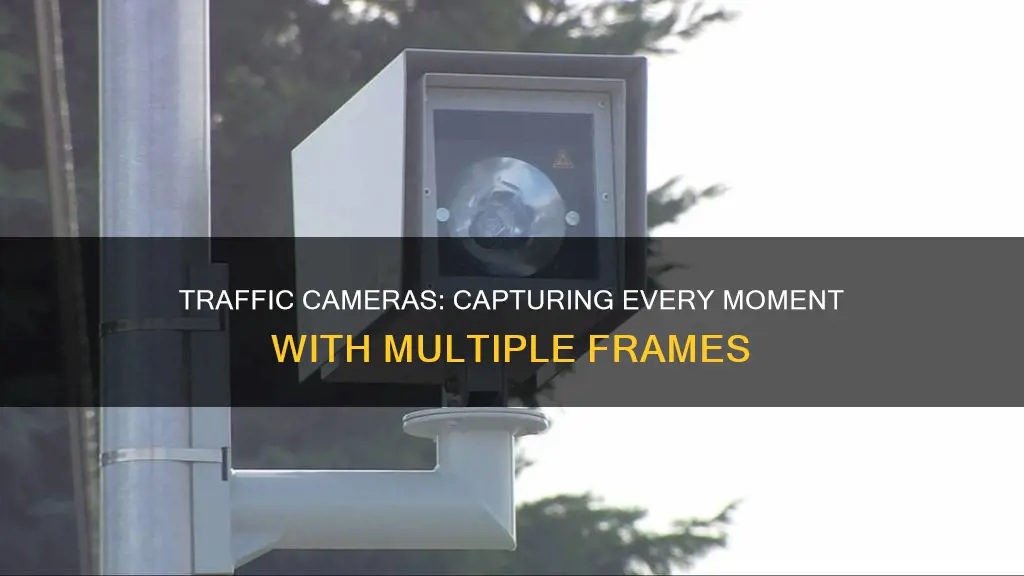
Traffic cameras are an essential component of intelligent transportation systems, aiding in monitoring vehicular traffic on roads, especially highways, freeways, and expressways. These cameras are typically positioned on high poles or masts along major roads and are connected by optical fibers, with power supplied by mains, solar panels, or alternative sources. While the primary purpose of traffic cameras is observation, they also play a crucial role in enforcing road rules and ensuring safety. The number of frames per second (FPS) in traffic cameras is a critical factor, as it determines the smoothness and detail of the captured footage. Higher FPS rates, typically ranging from 25 to 60, are essential for accurately capturing fast-moving vehicles and crucial details such as license plates, making it an indispensable tool for investigations and enforcement.
| Characteristics | Values |
|---|---|
| Frames per second (FPS) | 20-30 FPS for smooth video quality, with higher FPS for capturing fast-moving objects like cars |
| Object detection size | 5-30% of the screen width |
| Camera height | Optimal: 8-12 meters (26-40 feet); Minimum: 5 meters (16 feet); Maximum: 30 meters (98 feet) |
| Distance from monitored objects | Ensure vehicles or objects occupy at least 5% of the total scene size |
| Camera angle | Avoid exceeding a viewing distance of 70 meters (230 feet) for accurate tracking of all vehicle classes |
| Lighting conditions | Sufficient illumination for objects to be visible to the human eye |
| Lens cleanliness | Ensure camera lens is free from dirt, smudges, or scratches |
| Shutter speed | Avoid long shutter speeds to prevent motion blur |
What You'll Learn
- Traffic cameras have a recommended frame rate of 25-30 FPS for smooth video capture
- Higher FPS rates are required for capturing fast-moving objects
- Traffic cameras are typically installed on high poles or masts, or mounted on street lights
- The height of a traffic camera affects the quality of video analytics
- Traffic cameras are connected by optical fibres and powered by mains electricity, solar panels, or other alternative power sources

Traffic cameras have a recommended frame rate of 25-30 FPS for smooth video capture
Traffic cameras are essential for monitoring traffic conditions and detecting vehicles that break road rules. The frame rate, or frames per second (FPS), of these cameras is a critical factor in capturing clear and smooth footage. While there are no standard requirements for the FPS of traffic cameras, a rate of 25-30 FPS is recommended for smooth video capture.
A higher FPS results in smoother and more detailed video footage. In the context of traffic cameras, a higher FPS improves the clarity and precision of recorded movements, making it easier to identify vehicles, license plates, and other crucial details. This is particularly important for traffic enforcement, where evidence gathering and analysis are necessary for issuing tickets or taking legal action.
A frame rate of 25-30 FPS strikes a balance between capturing smooth video footage and managing file sizes. While higher FPS rates, such as 60 FPS, can be beneficial for monitoring fast-moving traffic on highways, they also result in larger video files. This can increase storage demands and impact the transmission and processing of footage.
It is worth noting that a minimum FPS of 10 is generally supported by most systems, but this lower rate is not recommended, especially in scenarios with fast-moving objects or heavy traffic. A lower FPS can lead to tracking errors and blurry images, compromising the effectiveness of traffic cameras as a surveillance tool.
To optimize the performance of traffic cameras, it is essential to consider factors such as camera placement, lighting conditions, and resolution. Ensuring that the camera is positioned at the recommended height, avoiding obstructions, and maintaining clear lenses can all contribute to capturing high-quality footage. Additionally, proper lighting, both natural and artificial, is crucial for the accuracy of video analytics, especially in low-light conditions.
In summary, a frame rate of 25-30 FPS is recommended for traffic cameras to achieve smooth and clear video capture. This rate balances the need for detailed footage with the practical considerations of file size and storage requirements. By adhering to these guidelines, traffic cameras can effectively serve their purpose of monitoring traffic flow, enforcing road rules, and enhancing road safety.
Side-View Cameras: Which Cars Have This Futuristic Feature?
You may want to see also

Higher FPS rates are required for capturing fast-moving objects
Traffic cameras are essential for monitoring and enforcing road safety, and the quality of footage they capture is critical for accurate data collection and analysis. One of the key factors influencing the effectiveness of these cameras is the number of frames per second (FPS) they can record.
FPS refers to the number of individual frames or images captured by a camera in one second and plays a pivotal role in the smoothness and detail of the video footage. Higher FPS rates are essential for capturing fast-moving objects, such as vehicles on highways, with clarity and precision. A higher frame rate allows for smoother animations, improved target tracking, and reduced system latency, all of which contribute to more reliable data collection.
For traffic cameras, a higher FPS is advantageous for several reasons. Firstly, it enables the camera to capture more detailed footage, which is crucial for identifying specific vehicles or events. This level of detail is particularly important for license plate recognition, facial recognition, and other identifying characteristics required for investigations and evidence gathering.
Secondly, higher FPS rates improve the overall smoothness of the video footage. This is especially beneficial for monitoring traffic flow, as it allows for seamless tracking of vehicles, even at high speeds. Smoother animations also assist in maintaining a clear view of the target, which is essential for accurate data collection and analysis.
Additionally, a higher FPS can help reduce system latency, which refers to the time it takes for actions (such as mouse clicks or movements) to reach the display. Lower system latency means that the camera can capture and display images with minimal delay, providing a more responsive system that can keep up with fast-moving objects.
While higher FPS rates offer these benefits, it is important to consider other factors as well. Higher FPS rates result in larger video file sizes, which can increase storage demands and impact bandwidth requirements. Therefore, a balance must be struck between a high FPS and other camera specifications, such as resolution and light sensitivity, to ensure optimal performance and efficient data management.
In conclusion, higher FPS rates are crucial for capturing fast-moving objects with traffic cameras. They provide smoother animations, improved target tracking, and reduced system latency, all of which contribute to more accurate and reliable data collection for road safety monitoring and enforcement.
The Best Way to Clean Your Car Camera
You may want to see also

Traffic cameras are typically installed on high poles or masts, or mounted on street lights
Traffic cameras are typically installed on high poles or masts or mounted on street lights. The height of the camera is critical to its effectiveness. According to experts, the optimal height for a traffic camera is between 8 and 12 metres (26 to 40 feet). This height allows the camera to capture both near and distant objects without obstruction.
Mounting a camera at a minimum height of 5 metres (16 feet) is recommended to prevent foreground objects from blocking the view. On the other hand, installing a camera higher than 30 metres (98 feet) can decrease detection accuracy, especially for smaller objects such as pedestrians, cyclists, and motorcyclists.
Traffic cameras are often placed strategically along roadsides, at intersections, and on highways to monitor traffic flow and enforce road rules. They can be fixed or mobile, with the latter being either handheld, tripod-mounted, or vehicle-mounted.
Fixed camera systems are typically housed in boxes or attached to poles, gantries, overpasses, or bridges beside the road. In contrast, mobile speed cameras may be mounted inside enforcement vehicles or set up temporarily on tripods.
The placement of traffic cameras can vary depending on local regulations and the specific needs of a location. For example, some jurisdictions may require cameras to be clearly visible to drivers, while others may allow for more discreet placements, such as concealing them in garbage bins.
Regardless of the specific installation method, the primary goal of traffic cameras is to improve road safety, reduce speeding, and deter traffic violations.
Hot Car, Camera Lens: Safe or Not?
You may want to see also

The height of a traffic camera affects the quality of video analytics
Traffic cameras are used to monitor and enforce road rules and safety. They can be used to detect speeding, vehicles running red lights, unauthorised use of bus lanes, and more. These cameras can be fixed, mounted on poles or buildings, or mobile, set up by law enforcement and moved around.
The height of a traffic camera plays a significant role in the quality of video analytics. The recommended height for optimal placement is between 8 and 12 meters (26 to 40 feet) above the ground. This height allows the camera to capture both near and distant objects without obstruction. At this height, the camera can monitor the desired area effectively, ensuring that objects in the foreground do not block those in the background.
Placing the camera lower than 5 meters (16 feet) may result in foreground objects obstructing the view and causing issues with accurate detection. On the other hand, mounting the camera higher than 30 meters (98 feet) can decrease detection accuracy, especially for smaller objects such as pedestrians, cyclists, and motorcyclists.
The height guidelines are essential to ensure the camera's effectiveness in capturing clear and unobstructed footage, which is crucial for accurate video analytics and enforcement of road rules.
In addition to height, other factors such as resolution, frame rate, shutter speed, lighting conditions, and weather conditions also influence the quality of video analytics from traffic cameras. A combination of these factors contributes to the overall performance and accuracy of the system.
Lumix Cameras: How Long Before a Recharge?
You may want to see also

Traffic cameras are connected by optical fibres and powered by mains electricity, solar panels, or other alternative power sources
Traffic cameras are an essential component of intelligent transportation systems, providing valuable real-time video footage for monitoring vehicular traffic and ensuring road safety. These cameras are strategically placed along major roads, highways, freeways, expressways, and arterial roads. One of the key features that set traffic cameras apart is their method of connection and power supply.
Traffic cameras are typically connected by optical fibres, as the name suggests, buried alongside or beneath the road. Optical fibres are flexible glass or plastic strands that can transmit light over long distances with minimal loss. This technology offers several advantages over traditional electrical cables, including higher data transfer rates, immunity to electromagnetic interference, and reduced need for signal amplifiers. The use of optical fibres ensures uninterrupted transmission of video data from the cameras to a central monitoring centre.
In terms of power sources, traffic cameras can be quite versatile. In urban areas, where electrical grids are readily available, traffic cameras often rely on mains electricity. This consistent power supply ensures that the cameras remain operational without disruptions. However, in remote locations beyond the reach of the electrical grid, alternative power sources become essential.
Solar panels play a crucial role in powering traffic cameras in these off-grid areas. Solar energy is harnessed through the installation of solar panels, which convert sunlight into electricity. This renewable energy source not only powers the cameras but also serves as a backup option for urban camera infrastructure, preventing power outages. The use of solar panels in remote areas ensures that critical safety equipment, such as those in tunnels, remain functional even during power disruptions.
While mains electricity and solar panels are the prominent power sources for traffic cameras, there is a growing trend towards exploring other alternative power sources. These sources aim to provide reliable and consistent energy to support the continuous operation of these vital surveillance tools. The specific alternative power sources utilised may vary depending on regional factors and available resources.
Traffic cameras play a pivotal role in road safety and traffic management, and their reliable operation is of utmost importance. By utilising optical fibres for data transmission and adopting a range of power sources, including mains electricity and solar panels, these cameras can function effectively, even in remote locations. This combination of technology and power solutions ensures a seamless flow of information to monitoring centres, enabling prompt responses to any incidents or safety concerns.
Charging the Heimvision Camera: A Step-by-Step Guide
You may want to see also
Frequently asked questions
Traffic cameras typically have a frame rate of 30 frames per second (FPS). This is the industry standard for precise, smooth video, even when capturing fast-moving vehicles.
A higher FPS rate results in smoother and more detailed video footage, which is crucial for effective surveillance and security systems. It helps security personnel better analyse and identify objects, individuals, or events within the camera's field of view.
A frame rate of 25 FPS and above is recommended for security cameras. Lower FPS rates, from 1 to around 25, often result in choppy footage.
The ideal FPS depends on various factors, including monitoring requirements, camera location and field of view, camera capabilities, bandwidth requirements, and storage requirements.
The height of a traffic camera is critical for optimal video quality and analytics. The optimal height is between 8-12 meters (26-40 feet) to capture both near and distant objects clearly.







